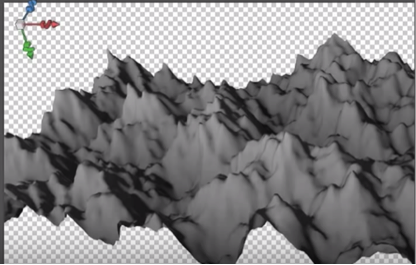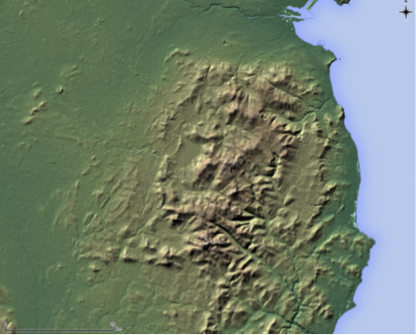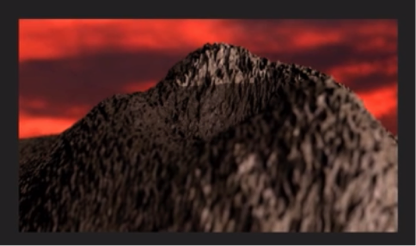w13 Work In Progress(CLJ)
- HildeMaassen
- Feb 14, 2019
- 5 min read
Updated: Aug 16, 2020
I have an eye abnormality where I see double without my glasses: fixation disparity. The left and right eyes are not in sync with each other and have a horizontal and vertical shift compared to the other. The result is that everyday things that normally don’t stand out at all, move and thus catch my eye. Even looking at a 2D object it moves forward and backward. I see the same kind of shifts back in the landscapes I make for this project as a result of the chosen technique. Playing around with the two words after looking them up in the dictionary gives an interesting perspective on the concept.
Disparity:
A great difference
Fixation:
1. Psychoanalysis: an obsessive interest in or
feeling about someone or something.
2. Biology: The action or process of fixing or being fixed.
3. Technical: The action of concentrating the eyes directly on something.
"The action of concentrating the eye on the landscape out of an obsessive interest and feeling about climate changing with the purpose to make a difference".
You are being screamed at
A photo is a 2D representation, framed by the photographer, of a 3D reality frozen in time.
By making a depth map based on the contrast and the colors in the photo, I show a hidden spatial experience of the photo. This results in surprising combinations where it seems like the photo and the world it represents is screaming at us. As if the photo, or part of it breaks open and shows what lives inside. The feeling of decay that speaks from the images is symbolic of this time of growing political tensions, climate changes, tsunamis and attacks. I remember being in Berlin when the wall fell the feeling of hope for the future. The idea that we would get a better world and that we were there at the beginning. And now the torn, desperate feelings, that it can only gets worse. That is what I hope you feel looking at the images. Will a new wall be built between Mexico and America?

During this project I want to experiment and research possibilities combining landscapes with their depth map to make a new, non-existentalmost carved reality. The idea to make a new kind of reality is not new for my projects. What is different to all the projects I did before is that I start with an image this time that I change afterwards. Normally I first create something and use photography in the end. I’II will not have all the controls and there is a certain unpredictability in the process. I do hope this stays that way because that will keep me amazed and therefore integrated and dedicated the outcome exciting everytime.
Before I started with this master, I always thought that my projects were very different from each other and that there was not really a connection. I did the things I did because I liked them, but I always felt a bit lost because of the lack of sense in my opinion. I have now found out that there is a relationship; I do not only make images of things that happen, but I always create the images, knead as you would with clay, as a sculptor would. Somewhere in the process I use a photographic process. It feels like the puzzle pieces are finally in place. And searching the Internet for photography in combination with sculpture the results are amazing and really speak to me.
What the final work will look like I want to keep open for the moment.
I really see this project as a research project and that means that I will definitely come up with a side path. But detours are sometimes so much more interesting than the fastest way from A to B.
Testing
I started this project because I was curious if it would be possible to render a flat, 2d photo again to 3d making a depte map using the color and contrast from the image. That did not yield an exciting picture, which is why I started combining it with the original 2d image. Rotating the dephtmap image with respect to the photo yielded surprising effects. The results are images with a kind of destruction.
The result is not predetermined. There are a lot of variations possible, so the same image can look completely different.

And when the computer hangs I get this kind of results (video)
Other "sculptor" photographers / artists
Not having of complete control is one of the things I like about the work of Berndnaut Smilde who created nimbus clouds himself inside of buildings and than takes photos of them. For that he uses a smoke-machine; a highly increased level of humidity in the space and some dramatic lighting. A semi-opaque cloud of tiny water-drops turns that way into an ambiguous dramatic sign. He wants to create an ominous situation, the same feeling I like to accomplish with my series of photos.

As a child I already knew Michel Szulc Krzyzanowski sequenties because his sister was a neighbor of mine. At that time he made his first series with sequences and I went to see one of the many exhibitions. I first met him in person 3 years ago because I arranged for him to give some lectures for my students. I wonder now if his work has inspired me unconsciously all those years.


Jan Dibbets went to the same high school as I did, years after him. Because he was already famous at the time we were taught about his projects. He started drawing but got famous when he added images.
Project perspective corrections; he made adjustments with the help of photography in the observation of simple forms, which he drew on floors, walls or expanded in the grass or sand. With the meticulous arrangement of photographs within a work, he made panoramas of panoramic views adapted by himself, Dutch Horizons.

Other work that I encountered while browsing the internet and that appeals to me because of the visual language.










© Joseph Parra
@Marcel Wesdorp (computer made)
References to technical approaches
Brendon Borellini is a blind and deaf photographer; the Depthmap X is printed so he can feel the images. A wonderfull way for him to know what his images look like.
Amanda Ghassaei uses the Depthmap to print images
Blender a plugin to make 3D images. The site were I found this has a link to the images made by the Nasa on Mars and shows photographs rendered to 3D The shape of the image, bottom left, speaks to me.





Geography
http://www.digital-geography.com/how-to-make-a-simple-topographic-map-in-arcgis-9-3-1-part-1/Inspiration
Photoshop; DepthmapX https://www.youtube.com/watch?v=CZpzoBRK8c4
Plugin to het DepthmapX in a map: http://planet.qgis.org/planet/tag/topography/
Photoshop and After effects: https://www.youtube.com/watch?v=z4Ub9SnnllE
Atlas plug-in Photoshop https://www.youtube.com/watch?v=Plcyi5KvCl8
People who inspire me because of their devotion to their work:
Carl de Keyzer; moments behoor the flood; "It now seems to be generally acknowledged that climate change, partly caused by human activity, will lead to a dramatic rise of the sea level in this century"
Sebastião Salgado and Lélia Wanick Salgado; Genesis
Jimmy Nelson; before they pass away
Frans Lanting and Christine Eckstrom
Murat Gerben: research on impacts of overurbanization and gentrification, civic rights and participatory citizenship, documentary sustainability of local cultures, human devastation of nature, climate change, global warming, water rights
Technical Possibilities yet to explore more
A tutorial how to make 3D model based on photographs http://paulbourke.net/miscellaneous/mreconstruction/
Lithro light field camera http://lightfield-forum.com/2014/10/researchers-develop-geometric-calibration-method-for-mla-based-light-field-cameras-using-line-features-in-raw-images/
Geography http://www.digital-geography.com/how-to-make-a-simple-topographic-map-in-arcgis-9-3-1-part-1/
Photoshop; DepthmapX https://www.youtube.com/watch?v=CZpzoBRK8c4
Plugin to het DepthmapX in a map: http://planet.qgis.org/planet/tag/topography/
Photoshop and After effects: https://www.youtube.com/watch?v=z4Ub9SnnllE
Possible Expiriments with the 3D part
3D Print and place in combinatoir with transparant film
Combine different images, angels
Combine negative and positive
Make the depthmap of the blurry image
Print depthmap and see if it is possible to print it as an etching
3D print, image on fabrick and combine
Depthmap image and normal image developped different
Animate








































































Comments